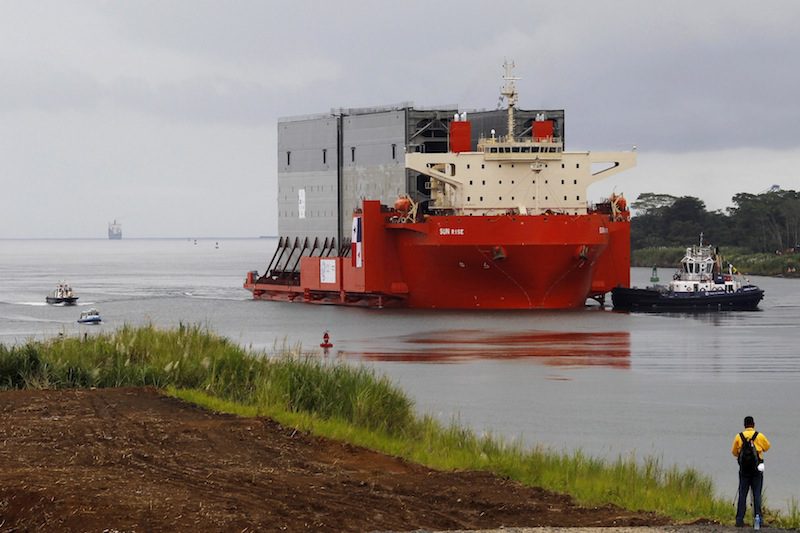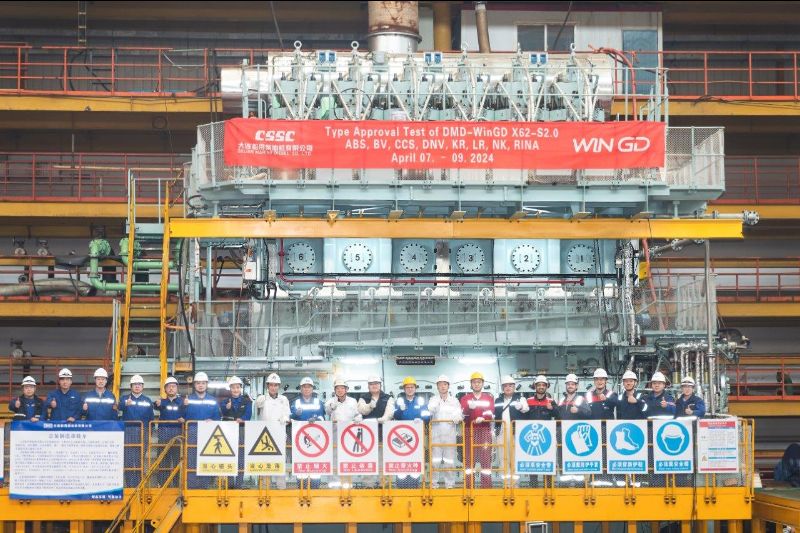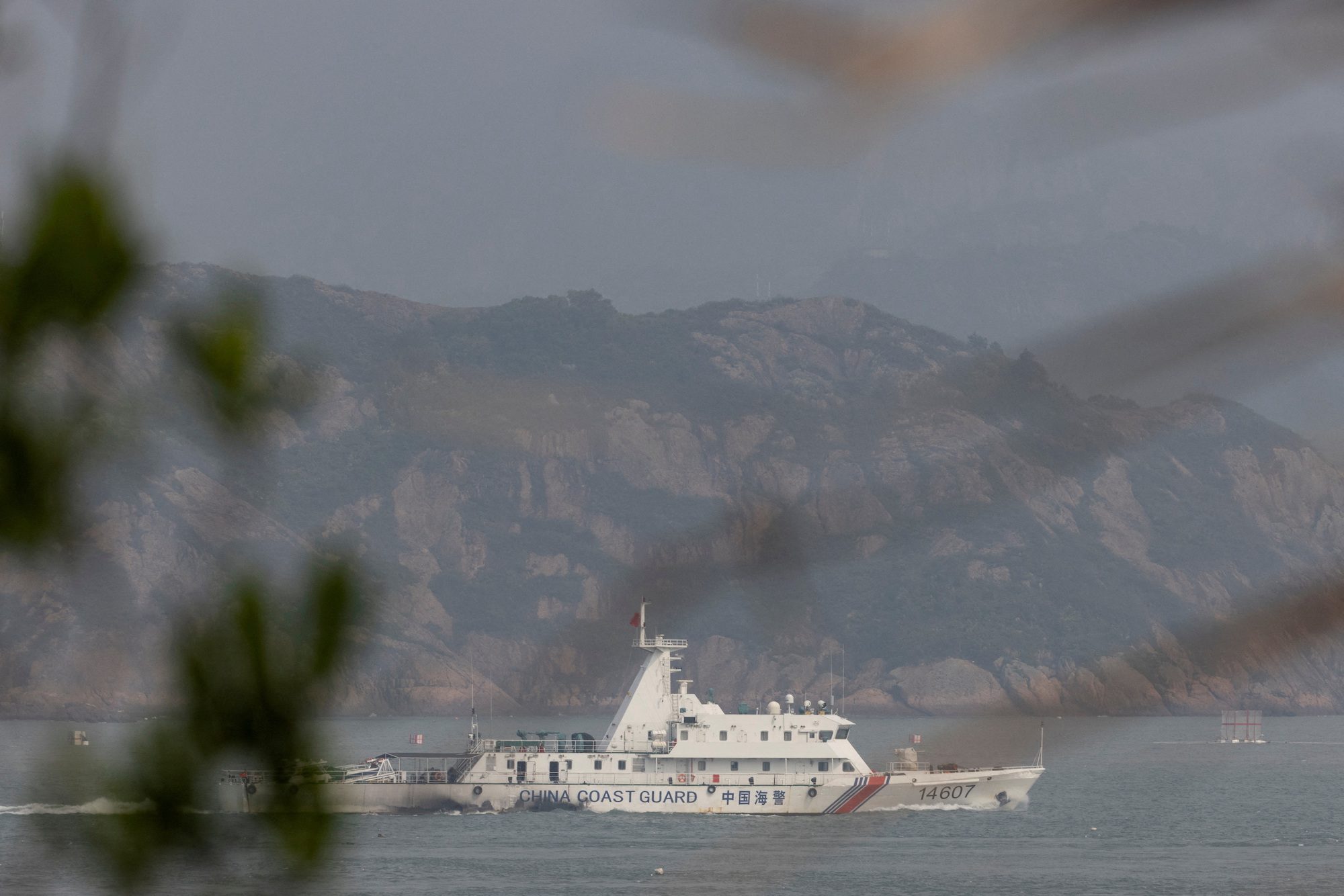
Panama Canal’s LNG Surprise to Redefine Trade in Fuel
The first four new gates for the Panama Canal’s third set of locks are seen on top of a cargo ship during their arrival to Colon in Colon City August 20, 2013 . REUTERS/ Carlos Jasso
By Isaac Arnsdorf
Nov. 5 (Bloomberg) — When the newly widened Panama Canal opens in 2015, it will handle an estimated 12 million metric tons of liquefied natural gas annually, a cargo planners didn’t even envision when starting the $5.25 billion expansion in 2007.
LNG carriers will cross the 48-mile waterway 350 times a year, and voyages to Asia from the U.S. will cost 24 percent less than longer routes, according to calculations from the canal authority. The expected 12 million tons, assuming half the transits are hauling cargoes, would be equal to about 5 percent of the world’s trade in 2012, Fearnley Consultants AS estimates.
The U.S., now the world’s largest producer of natural gas because of the extraction of fuel from shale rocks, will account for much of that traffic as it becomes the third-largest exporter of LNG by 2020, Morgan Stanley estimates. With American energy independence now at a 27-year high of 86 percent, the route will boost exports to Japan, offsetting nuclear-power generation lost after the earthquake and tsunami in March 2011.
“There’s a huge market in Asia, a huge resource in the United States, and the Panama Canal is an enabler of this trade, reducing the cost of getting LNG to the market,” said Sverre Bjorn Svenning, an analyst at Fearnley in Oslo, who managed a research project a decade ago for the waterway’s expansion. “We didn’t see this coming.”
LNG Tankers
Construction to double the canal’s capacity is 64 percent complete, the Panama Canal Authority said on its website Sept. 10. The expanded waterway will be able to handle ships as long as 1,200 feet and as wide as 160 feet, compared with the current 965 feet and 106 feet, data on the website show.
That will accommodate 89 percent of the world’s LNG carriers by 2015, Silvia Marucci, a liquid-bulk specialist at the canal authority, said at a conference in Singapore Oct. 30. LNG tankers will cross the canal about 850 times by 2025, she estimates. Only 4 percent of the 369 ships can fit through the waterway now, and just six of the vessels have entered in the past five years, according to data from IHS Maritime, a Coulsdon, England-based research company.
“This is a surprise for everybody — nobody was expecting LNG to be flowing out of the United States,” Marucci said by phone Oct. 23. “We have had the same markets for a long time, and this possibility of receiving a new market that we have never seen before is a challenge for us and a great opportunity.”
$8 Million
The round-trip voyage to Fukuoka, Japan, from Sabine Pass, Louisiana, will cost $8 million and take 43.4 days through the canal, instead of $11.4 million and 63.6 days around Africa, Marucci said. The calculation assumes a 150,000 cubic-meter (5.3 million cubic feet) tanker hired for $85,000 a day sailing at 18.5 knots, burning 25 tons of fuel at $613 a ton and using 180 cubic meters of LNG daily for fuel, known as boil-off.
For a standard 150,000 cubic-meter tanker, tolls may total $347,400 with a cargo and $295,500 when empty, according to preliminary figures in a presentation made by canal officials in February, a copy of which was obtained by Bloomberg News. The fees are still being discussed and will be finalized in the first half of next year, Monica Martinez, a spokeswoman for the authority, said by e-mail Oct. 23.
Teekay LNG Partners LP, a Hamilton, Bermuda-based ship owner, already booked two tankers to carry U.S. exports on five- year contracts, the company said in June. The vessels are designed to haul as much cargo as possible through the expanded canal, said David Glendinning, president of the Teekay Gas Services division.
Increased Trade
Ship owners will benefit from increased trade and longer voyages from the U.S. compared with suppliers such as Australia, said Christian Waldegrave, Teekay’s market research manager. Shares of Teekay LNG Partners gained 9.2 percent to $41.26 this year and will reach $45 in 12 months, according to the average of four analyst estimates compiled by Bloomberg.
Golar LNG Ltd., led by billionaire John Fredriksen, has nine LNG carriers and is building 11 more, according to its website. Shares of the Hamilton, Bermuda-based company rose 1.6 percent to $37.36 this year and will advance to $41.36 in 12 months, the average of 14 estimates shows. Company officials didn’t respond to an e-mail and voice message seeking comment.
Buyers Benefit
Buyers and sellers will have lower costs and ship owners will profit from more trade, said Erik Nikolai Stavseth, an analyst at Arctic Securities ASA in Oslo. He recommends buying Golar and AwilcoLNG AS, whose shares fell 17 percent to 16.10 Norwegian kroner this year and will rebound to 18.68 kroner in 12 months, according to the average of six analyst estimates compiled by Bloomberg.
When the canal’s expansion started in 2007, the U.S. was importing 770.8 billion cubic feet of LNG a year, making it the fourth-largest buyer behind Japan, South Korea and Spain, Energy Department data show. It had one export facility in Alaska, which is now mothballed.
Using techniques including hydraulic fracturing and horizontal drilling to unlock gas resources in shale rocks, the U.S. became the world’s biggest natural-gas producer last year, according to BP Plc data. LNG imports plunged from a record 98.7 billion cubic feet in April 2007 to as little as 5.2 billion cubic feet in April 2013, Energy Department data show.
Price Gap
Natural-gas futures dropped 78 percent to $3.426 per million British thermal units from the all-time high of $15.78 reached in 2005. Prices will average $3.50 in 2014 and $4 in 2015, Morgan Stanley estimates. That compares with this year’s average of $16.32 in Japan, the world’s largest importer, according to data from LNG Japan Corp.
“The major driver that supports exports is the differential between natural gas in the U.S. versus Asian LNG pricing,” said Bobby Gaspard, vice president of LNG marketing at Freeport LNG Development LP, which is planning a Texas export terminal for 13.2 million tons by 2019. “The expanded Panama Canal just improves the shipping, and it’s a fairly significant improvement in costs, especially if these preliminary-type numbers actually hold.”
Asian buyers have already booked two-thirds of Freeport’s capacity. Two other projects have been approved, and about 19 more permits to export LNG are pending at the Energy Department. U.S. export capacity will reach 72 million tons by 2020, exceeded only by Australia and Qatar, according to Morgan Stanley.
Sabine Pass
Cheniere Energy Inc.’s terminal at Sabine Pass, Louisiana, will process 9 million tons a year when it opens in 2015, eventually rising to 27 million, according to the Houston-based company. Shares more than doubled to $39.54 this year and will reach $43.33 in 12 months, according to the average of six analyst estimates compiled by Bloomberg.
“The Panama Canal widening will improve the competitive position of LNG exports from the U.S. Gulf Coast and provide buyers in Asia with more opportunities to source supply,” Diane Haggard, a spokeswoman for Cheniere, said by phone Oct. 31. “It will facilitate trade and development of the global LNG market.”
Asia will lead growth in demand as Japan and South Korea reduce their use of nuclear power. Importers need contracts for another 70 million tons a year by 2020 and 180 million tons by 2025, Goldman Sachs Group Inc. said in a Sept. 23 report.
The canal also may be used for voyages to Spain from Peru and to Chile from Trinidad and Tobago, Marucci said. Peru shipped 1.9 million tons to Spain in 2012, while Trinidad and Tobago sent 2.1 million tons to Chile, according to data from the International Group of LNG Importers.
“The proposed tolls lend a big benefit to using the Panama Canal, and it tells me the canal is really trying to attract LNG vessels,” said Stavseth of Arctic Securities, whose recommendations on the shares of shipping companies returned 23 percent in the past year. “The export facilities are counting on that in a big way. It’s a no-brainer.”

Subscribe for Daily Maritime Insights
Sign up for gCaptain’s newsletter and never miss an update
— trusted by our 109,123 members

Get The Industry’s Go-To News
Subscribe to gCaptain Daily and stay informed with the latest global maritime and offshore news

 Join The Club
Join The Club








